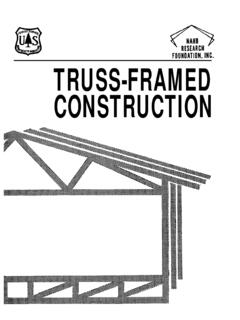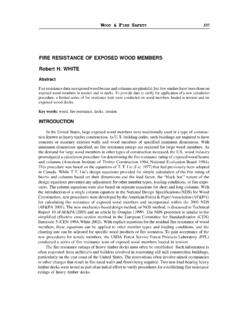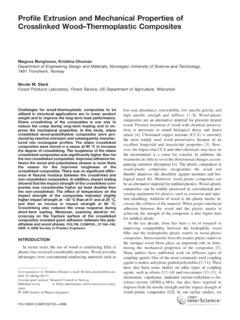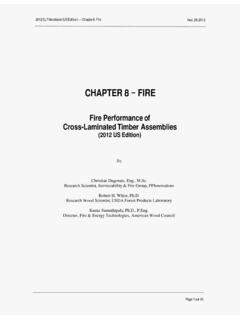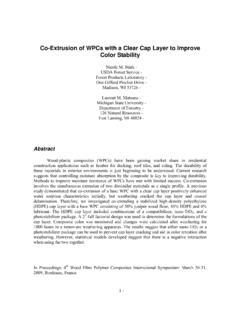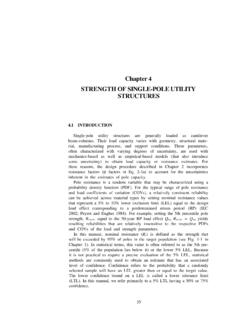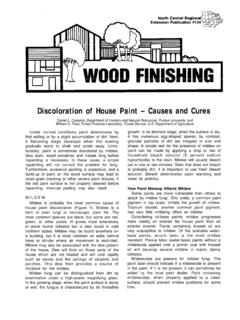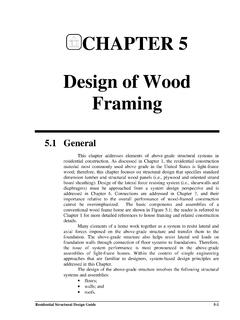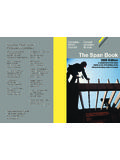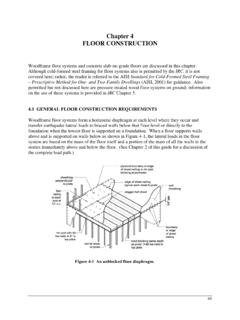Transcription of Wood Particleboard and Flakeboard Types, Grades, and Uses
1 United StatesDepartment ofAgricultureForest ServiceForestProductsLaboratoryGeneralTe chnicalReportFPL-GTR-53 Wood Particleboardand FlakeboardTypes, Grades, and UsesAbstractPageThis report is for those who use ormay want to use wood term Particleboard is used asdefined in the American Society forTesting and Materials (ASTM)Standard D 1554, which includesflakeboards as a subclass ofparticleboards, and not as used in thelumber trade where the term is usuallyreserved for panels made of fine woodparticles such as sawdust and planershavings. Types and grades ofparticleboard are described anddiscussed in relation to end uses asnonstructural underlayment, stairtread, shelving, furniture, corematerial, cabinetry, structuralsheathing, subflooring andcombination subfloor/underlayment,and siding. The structural panels usedin light- frame construction areprimarily : End uses, Particleboard , Flakeboard , waferboard, strandboard,composite plywood, underlayment,stair tread, shelving, furniture,sheathing, siding, mobile home,building codes, 1986 Carll, Charles.
2 Wood Particleboard andflakeboard: Types, grades, and uses. Rep. FPL-GTR-53. Madison, WI: of Agriculture, Forest Service,Forest Products Laboratory; 1986. 9 limited number of free copies of thispublication are available to the public from theForest Products Laboratory, One GiffordPinchot Drive, Madison, WI publications are sent to over 1,000libraries in the United States and Laboratory is maintained in cooperationwith the University of What IS it? ..1 Standards for Particleboard ..1 Particleboard Applications.. Tread and for Industrial and and Roof Particleboardand FlakeboardTypes, Grades, and UsesCharles Carll, Research Forest Products TechnologistForest Products Laboratory, Madison, WIParticleboard What Is It?Wood particleboards aremanufactured as panels from drywood particles that have beensprayed or dusted (speckled) with abinder resin, and are bonded togetherwith pressure and heat.
3 Particles forthe boards can be made from almostany type of wood, whether whole logsor wood residues such as trimmingsand shavings from lumber or plywoodmanufacturing. Many species areused, although the lower densitywoods are preferred. In this paper, theterm Particleboard includes anumber of different panel typessometimes referred to variouslyas chipboard, Flakeboard , strandboard, or waferboard, depending on size and shape of thewood particles used. (See Glossaryfrom ASTM D 1554 below.)Almost all Particleboard is producedby pressing a mat of resin-speckledparticles flatwise in a heated boards produced by forcingthe resin-speckled particles betweenparallel heated dies represent aminiscule proportion of theparticleboard forParticleboardParticleboard panels are currentlyavailable for many end uses.
4 All butone (oriented strandboard) of theparticleboards commercially availableare addressed in the AmericanNational Standard, ANSI format-formed wood under the auspices of theAmerican National Standards Institute,ANSI is a voluntary productstandard, which means that producersare not restricted to the manufactureof particleboards conforming to thestandard. Conformance to thestandard is required only when boardsoffered for sale are represented asconforming to the standard, or when acustomer requests a certain gradefrom the standard, or when requiredby a design specification or ANSI Standard dimensional tolerances ofpanels and required minimal levels ofphysical and mechanical properties forvarious grades of 1 and 2, reproduced fromANSI Standard , state propertyrequirements for the panel gradesaddressed in this standard.
5 TheStandard recognizes panel types 1and 2, indicated by the first number inthe grade designation. Type 1 panels( table 1) are manufactured with anadhesive (or binder resin) which hassome water resistance but is notwaterproof, usually urea-formaldehydebinder resin. Type 2 panels ( table 2),including waferboard (2-MW) andflakeboard (2-MF), are manufacturedwith a waterproof binder resin, usuallyphenol-formaldehyde. Use of aphenolic binder resin does notnecessarily result in a particleboardpanel suitable for permanent exteriorexposure, just as use of phenolicwaterproof adhesive in sheathingplywood does not result in a plywoodpanel intended for permanent the two panel typesrecognized in ANSI Standard ,the grade specification indicatesdensity classes by the letters H (high),M (medium), and L (low).
6 With woodat 7 percent moisture content, theseclasses approximate density values ofover 50 pounds per cubic foot (lb/ft3)(H), 40 to 50 lb/ft3 (M), and less than40 lb/ft3 (L). Particleboard ApplicationsThe strength-stiffness requirementsfor different grades listed in tables 1and 2 are not intended to be used asdesign values for construction. Theproperty values listed in the tables arefor grade certification and qualitycontrol where test conditions andmethods are precisely controlled andfollow provisions outlined in theAmerican Society for Testing andMaterials (ASTM) Standard D conditions may differ fromthose specified in this standard. Thestrength and stiffness values listed intables 1 and 2 are several times thedesign values that would beappropriate for use of these materialsin engineered the date of this writing, revisionof ANSI is expected to resultin separate standards for fine furnishparticleboards and for American Plywood Association(APA) and Timber EngineeringCompany (TECO) have publishedperformance standards for sheathingand for combination subfloor andunderlayment.
7 The Council ofAmerican Building Officials ResearchBoard, which is sponsored jointly bythe three model building codes (seereference section), has recognizedthese APA and TECO performancestandards. Certain particleboardpanels (most notably a number offlakeboard products) meet theseperformance standards and thus havemodel-building-code recognition foruse as sheathing or combinationsubfloor and underlayment. In fact,most of the Flakeboard panelsmarketed for these uses beargradestamps showing conformance tothe APA or TECO performancestandards. The model building codes,their authors, and addresses are listedin the reference section of uses of board products arediscussed in the following any of these uses it is advisableto purchase panels produced under acertified quality program, whereestablished grade marks on the panelidentify the use, grade, or quality ofthe panel, and the mill at which itwas manufactured.
8 Six differentorganizations administer certifiedquality programs for Particleboard orparticleboard-veneer compositesmanufactured in the United States andCanada. These organizations arelisted in the reference of grade 1-M-1, , are manufactured for floorunderlayment where theyprovide a smooth, level, andindentation-resistant surface for thesubsequent application of carpeting orresilient-finish floors such as linoleum,vinyl, or vinyl-asbestos Particleboard isnonstructural and has no codeapproval for use as subflooring orsingle-layer 1 shows a specimen ofunderlayment-grade (discussed in subsequentparagraphs) is sometimes used asunderlayment, particularly 1 Specimen of underlayment Particleboard . (Numberedscale in inches.) (M 150 064)2 table 1. Property requirements for grades of type 1 mat-formed particleboarda (Average values for sample consisting of 5 panels)bGradeLengthandwidthtoleranceThic knesstolerancePanelWithinaveragedpaneleM odulusModulusofofruptureelasticityIntern albondHardnessLinearexpansionmaximumaver ageScrewholdingFaceEdge---------------in ------------------------------ 1/16 ,400350,000130500 NSc4003001-H-2 1/16 ,000350,0001301,000NS4253501-H-3 1/16 ,400400,0001401,500NS4503501-M-1+0 -1/8+ ,600250, 1/16 ,100325, 1/16 ,400400, 1/16+ , with urea-formaldehyde resin binders or equivalent bonding for dimensional tolerances which are individual panel not average from measurement from panel 2.
9 Property requirements for grades of type 2 mat-formed particleboarda (Average values for sample consisting of 5 panels)bGradeLengthandwidthtoleranceThic knessetolerancePanelWithinaveragespanelh ModulusofruptureModulusofelasticityInter nalbondHardnessLinearexpansionmaximumave rageScrewholdingFaceEdge---------------- in----------------2-H-1 1/16 1/16 ,2---------------- ,400350,000 ,400400,000 ,800250,000 ,500450,000 ,000500,000 ,500450,000 ,000500,000 +0 -1/8+0 -1/8+0 -1/82-M-12-M-22-M-32-MWc2-MFf+0 -1/8+0 -1/8 , with phenol-formaldehyde resins or equivalent bonding for dimensional tolerances which are individual panel W indicates that this product is made from not tolerance values shown are for sanded panels as defined by the manufacturer. Values for unsanded panels for all 2-M Grades shall be for panel averageand for within F indicates that this product is made from average from measurement from panel underlayment isattached to lumber or plywoodsubflooring with ring-groovedunderlayment nails or galvanizeddivergent-chisel-point power-drivenstaples.
10 Glue-nailing with hard-settingcasein glue or polyvinyl acetate floorunderlayment glue provides superiorattachment. The reader is referred tothe booklet How to InstallParticleboard Floor Underlayment published by the NationalParticleboard Association. Thisinstruction guide was written beforeflakeboards came into use asstructural subfloor and hence does notmention how to attach underlaymentparticleboard to a Flakeboard , the application would be thesame as to lumber or plywoodsubfloor. In new construction,single-layer subfloor/underlayment isoften used, eliminating the need forattachment of underlayment Tread andShelvingSome urea-bonded fine-furnishparticleboard is produced for useas interior stair tread. The of Housing and UrbanDevelopment (HUD) has published aUse of Materials Bulletin (UM 70a) forparticleboard interior stair treads.
